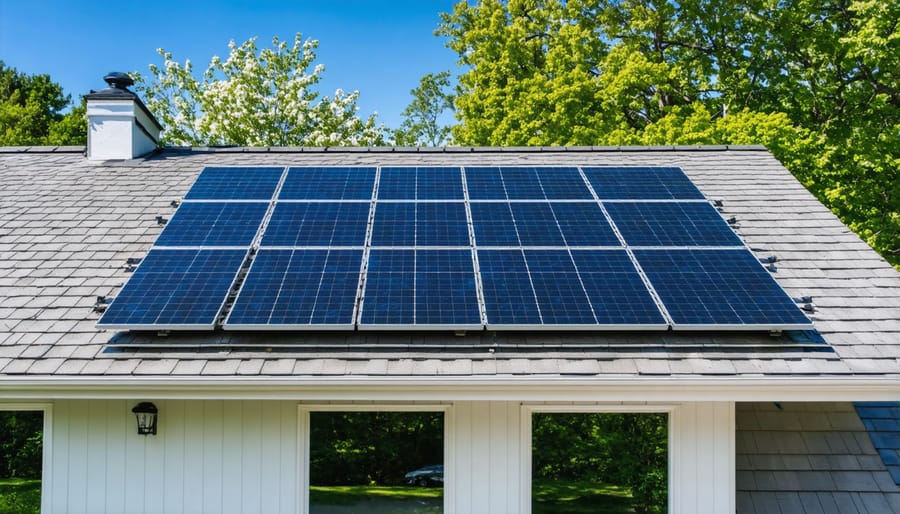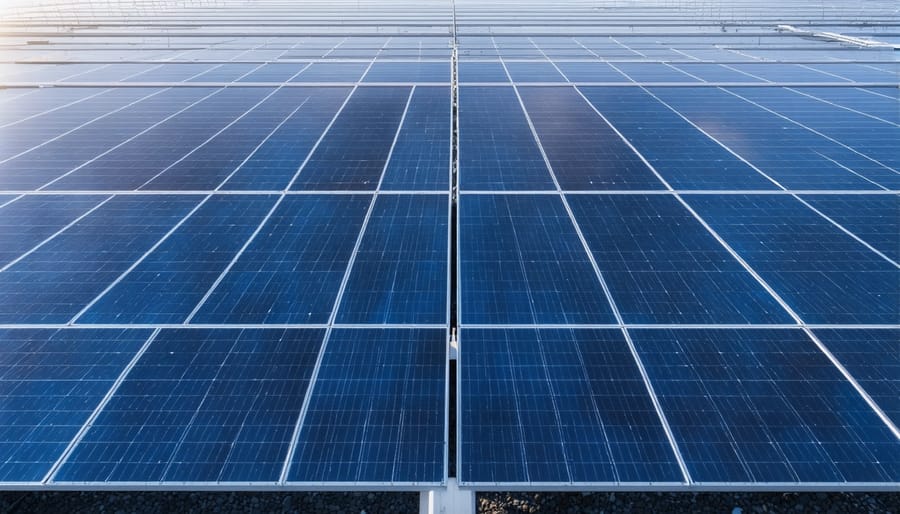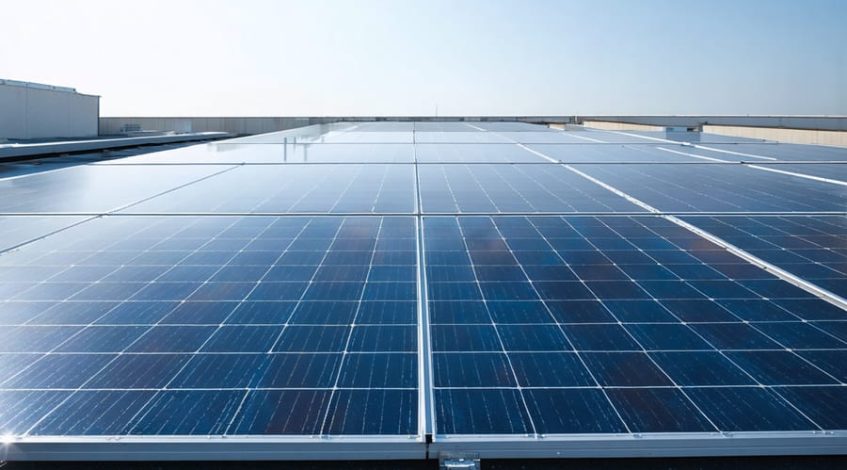The optimal tilt angle of your solar panels can dramatically maximize your energy output and financial returns, with research showing up to 40% efficiency improvements through precise positioning. Setting panels at your location’s latitude angle typically delivers peak annual performance, while adjusting this angle by ±15° between seasons can increase generation by an additional 10-15%. For commercial installations in the Northern Hemisphere, a south-facing orientation combined with a tilt between 30-45 degrees consistently yields optimal results across most geographical locations. Advanced monitoring systems now enable facility managers to fine-tune panel angles based on real-time performance data, ensuring maximum ROI throughout the system’s operational lifetime. This precision in panel positioning, combined with proper maintenance protocols, has helped leading commercial installations achieve payback periods as short as 4-6 years while maintaining peak efficiency for decades.
The Science Behind Solar Panel Tilt Angles
Geographic Location and Latitude Impact
Geographic location plays a crucial role in determining the optimal tilt angle for solar panels, primarily due to its relationship with latitude. As a general rule, the optimal tilt angle closely corresponds to the installation site’s latitude, with slight adjustments based on seasonal variations and local climate conditions.
For installations in the Northern Hemisphere, panels should face true south and be tilted at an angle approximately equal to the location’s latitude. For example, a facility in Boston (42°N) would typically set panels at around 42 degrees, while a installation in Miami (25°N) would use a shallower angle of about 25 degrees.
However, local factors can modify these calculations. Coastal areas might benefit from slightly steeper angles to compensate for morning fog, while desert regions often perform better with shallower angles to capture more mid-day sun. Seasonal adjustments can also enhance performance, with steeper angles (latitude plus 15 degrees) preferred in winter months and shallower angles (latitude minus 15 degrees) in summer.
Industry best practices suggest conducting site-specific assessments to account for these geographic variables, ensuring optimal energy production throughout the year.

Seasonal Sun Path Variations
The Earth’s position relative to the sun changes throughout the year, significantly impacting the optimal tilt angle for solar panels. During summer months, the sun travels a higher path across the sky, resulting in more direct sunlight hitting the Earth’s surface. Conversely, solar panel efficiency in winter is affected by the sun’s lower position, requiring different panel orientations for maximum energy capture.
These seasonal variations mean that a fixed tilt angle represents a compromise between summer and winter conditions. While the ideal angle would change daily, most installations opt for a fixed position that optimizes annual energy production. This angle typically equals the installation site’s latitude, with adjustments of +15 degrees in winter and -15 degrees in summer for maximum efficiency.
For commercial installations, tracking systems that automatically adjust panel angles throughout the day and seasons can increase energy yield by 25-35%. However, these systems require additional investment and maintenance considerations, making fixed installations more common for most applications.
Calculating Your Optimal Tilt Angle

Fixed vs. Adjustable Tilt Systems
When considering solar panel installation, facility managers must choose between fixed and adjustable tilt systems, each offering distinct advantages for different applications. Fixed tilt systems, while more economical upfront, maintain a constant angle optimized for the installation location’s latitude. This smart panel positioning approach requires minimal maintenance and provides reliable year-round performance.
Adjustable tilt systems, though initially more expensive, enable seasonal angle modifications to maximize energy capture. These systems typically allow for bi-annual or quarterly adjustments, potentially increasing energy yield by 5-15% compared to fixed installations. This advantage is particularly notable in regions with significant seasonal solar path variations.
The choice between fixed and adjustable systems often depends on several factors:
• Installation location and latitude
• Available maintenance resources
• Project budget constraints
• Energy production targets
• Roof or ground mount configuration
For commercial installations, fixed systems generally offer the best ROI due to their lower maintenance requirements and installation costs. However, larger utility-scale projects may justify the additional investment in adjustable systems, especially when operational staff can perform regular adjustments.
Many facility managers find that the simplified maintenance and reliability of fixed systems outweigh the potential gains from adjustable options, particularly in urban environments where access for adjustments may be limited.
Commercial Installation Considerations
Commercial solar installations require careful consideration of additional factors beyond those for residential applications. Building codes, roof load capacity, and local zoning regulations often dictate the final tilt angle decision. For large-scale installations, wind load calculations become particularly crucial, as commercial panels typically cover more extensive surface areas.
Space optimization is a key consideration for businesses. While the theoretical optimal tilt angle might be 30-40 degrees in many locations, commercial installations often use lower tilt angles (5-15 degrees) to maximize the number of panels that can fit on a given roof area. This approach typically results in only a minimal energy production loss while significantly increasing the total system capacity.
Maintenance requirements also influence tilt angle decisions. Flatter installations (10-20 degrees) generally accumulate more dust and debris, necessitating more frequent cleaning, but they provide easier access for maintenance crews. Many commercial facilities opt for a compromise between optimal energy production and practical maintenance considerations.
Financial considerations often drive commercial tilt angle decisions. While a steeper tilt might maximize winter production, businesses with high summer cooling loads might benefit from a shallower angle to match peak production with peak demand. This alignment can significantly impact demand charges and overall ROI.
For multi-building campuses or industrial parks, shadow analysis becomes critical. The tilt angle must account for potential inter-row shading and surrounding structures to ensure consistent energy production throughout the facility.

Real-World Performance Data
Energy Production Comparisons
Research data demonstrates significant energy production variations based on solar panel tilt angles. Studies show that optimally tilted panels can generate 10-25% more electricity compared to panels installed at suboptimal angles. In northern latitudes, panels tilted at the optimal angle of latitude plus 15 degrees produce approximately 12% more energy during winter months than flat-mounted installations.
A comparative analysis across multiple commercial installations revealed that properly angled panels achieve peak performance for an average of 5.5 hours daily, while poorly tilted panels reach maximum efficiency for only 3.8 hours. This translates to an annual energy production difference of 1,200-1,800 kWh per installed kW capacity.
Field tests conducted on identical 100kW systems in California demonstrated that panels set at the optimal 34-degree tilt generated 157,000 kWh annually, while those at a 10-degree tilt produced 142,000 kWh – a 9.5% reduction in energy yield. These real-world performance metrics underscore the importance of precise angle calculations in maximizing system output and investment returns.
ROI Impact Analysis
Proper solar panel tilt angle significantly impacts financial returns on solar investments. Studies show that optimally tilted panels can maximize your ROI by increasing energy production by 15-25% compared to poorly oriented installations. For a typical 100kW commercial system, this optimization can translate to additional annual savings of $3,000-$5,000 in electricity costs.
The financial impact becomes particularly evident over the system’s lifetime. A properly tilted installation can generate up to $75,000 in additional revenue over 25 years for medium-sized commercial installations. Even a 5-degree deviation from optimal tilt can result in 1-3% annual energy loss, highlighting the importance of precise orientation.
Recent case studies from Australian commercial installations demonstrate that businesses achieving optimal tilt angles recover their investment up to 2.5 years faster than those with suboptimal orientations. This acceleration in payback period, combined with increased energy production, makes proper tilt angle optimization a crucial factor in solar project planning and implementation.
Determining the optimal tilt angle for solar panels is a critical factor that significantly impacts system performance and return on investment. While general guidelines suggest matching the installation latitude or adjusting seasonally, each facility’s unique characteristics demand careful consideration of multiple variables. Factors such as local weather patterns, surrounding structures, and specific energy consumption needs all play vital roles in determining the ideal angle. For maximum system efficiency and ROI, we strongly recommend consulting with qualified solar installation professionals who can conduct detailed site assessments and use advanced modeling tools. These experts can provide customized recommendations based on your specific location, energy goals, and facility requirements, ensuring your solar investment delivers optimal performance throughout its operational lifetime. Remember that proper panel orientation is not just about maximizing energy production—it’s about achieving the best possible balance between system efficiency, maintenance requirements, and long-term cost savings.

